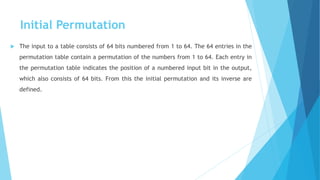Block ciphers like DES encrypt data in blocks and use a symmetric key known to both the sender and receiver. The AES block cipher is commonly used today. It operates on 128-bit blocks and supports key sizes of 128, 192, or 256 bits. The AES algorithm consists of repeated rounds of substitutions, shifts, and XOR operations with a expanded key schedule. It was designed to improve upon DES by having stronger cryptography and being more computationally efficient.














![ If you clearly observe that the output of the first round of the decryption process
is equal to a 32-bit swap of the input to the sixteenth round of the encryption
process. First, consider the encryption process.
LE16 = RE15
RE16 = LE15 x F(RE15, K16)
On the decryption side,
LD1 = RD0 = LE16 = RE15
RD1 = LD0 x F(RD0, K16)
= RE16 x F(RE15, K16)
= [LE15 x F(RE15, K16)] x F(RE15, K16)](https://image.slidesharecdn.com/unit-2-190816154643/85/Unit-2-15-320.jpg)

























![Detailed structure
It is not a Feistel structure. In this process the entire data block in parallel during each
round using substitutions and permutation.
The key that is provided as input is expanded into an array of forty-four 32-bit words, w[i].
Four distinct words (128 bits) serve as a round key for each round; these are indicated in
Figure(b).
Four different stages are used, one of permutation and three of substitution:
Substitute bytes: Uses an S-box to perform a byte-by-byte substitution of the block
ShiftRows: A simple permutation
MixColumns: A substitution that makes use of arithmetic
AddRoundKey: A simple bitwise XOR of the current block with a portion of the expanded key](https://image.slidesharecdn.com/unit-2-190816154643/85/Unit-2-41-320.jpg)






















![For decryption, the same scheme is used,
except that the received ciphertext unit is XORed with the output of the
encryption function to produce the plaintext unit.
Let Ss(X) be defined as the most significant s bits of X. Then
C1 = P1 Ss[E(K,IV)]
Therefore,
P1 = C1 Ss [E(K, IV)]](https://image.slidesharecdn.com/unit-2-190816154643/85/Unit-2-64-320.jpg)























![Type 1: I = ((Kmi + D) <<< Kri)
f = ((S1[Ia] ⊕ S2[Ib]) - S3[Ic]) + S4[Id]
Type 2: I = ((Kmi ⊕ D) <<< Kri)
f = ((S1[Ia] - S2[Ib]) + S3[Ic]) ⊕ S4[Id]
Type 3: I = ((Kmi - D) <<< Kri)
f = ((S1[Ia] + S2[Ib]) ⊕ S3[Ic]) - S4[Id]
Rounds 1, 4, 7, 10, 13, and 16 use f function Type 1.
Rounds 2, 5, 8, 11, and 14 use f function Type 2.
Rounds 3, 6, 9, 12, and 15 use f function Type 3.](https://image.slidesharecdn.com/unit-2-190816154643/85/Unit-2-88-320.jpg)


